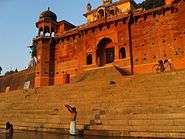Chait Singh
Rafa'at wa Awal-i-Martabat Raja Sri Chait Singh Sahib Bahadur (d. 29 March 1810) commonly known as Chait Singh was a ruler of Benares State in northern India.

Chait Singh was the eldest son of Raja Balwant Singh, and succeeded to the throne of Benares in 1770 after the death of his father. During the Eighteenth Century in northern India, the Mughal Empire was disintegrating, while the power of the British East India Company was growing. Balwant Singh was a zamindar who took the title of raja, and rajas of Benares were still formally subject to the Nawab of Awadh (Oudh). The Nawab wished to hold total suzerainty over the zamindari. British authorities encouraged the Nawab to recognise Chait Singh as zamindar in 1773.
In 1775 the Nawab, by now fed up with British interference, transferred the domain to the Company under the direct control of the Governor-General of India, Warren Hastings. Under the new British terms, Chait Singh was empowered to contribute cavalry and maintenance grants for the Company's sepoy battalions. The Raja refused to do this and he began to secretly correspond with enemies of the Company in hopes of forcibly breaking the arrangement. The company discovered his plan, stripped him of his position and placed him under house arrest in August 1781, pending an interview with Hastings. He escaped, killing his unarmed guards and gathered his small forces, appealing for assistance from local rulers, who did nothing. In skirmishes with the Company's forces, Chait Singh's troops were defeated, the rebellion crushed, and the zamindari confiscated and given to his nephew Rafa'at wa Awal-i-Martabat Raja Sri Mahip Narayan Singh Sahib Bahadur on 14 September 1781.
Chait Singh himself took shelter in Awadh, and then Gwalior, where he was granted a jagir for a while until it was later confiscated. He died in Gwalior on 29 March 1810 in obscurity, leaving three sons. The incident greatly tarnished Hastings' image and capability, leading to a failed attempt to impeach him by the British parliament.
Chait Singh's nephew, Raja Sri Mahip Narayan Singh Sahib Bahadur, succeeded his maternal uncle on 14 September 1781 under the terms of the British East India Company, which were that he should serve to dispense justice within his domains and make an annual contribution of 40 lakhs.
Carved stone from Chait Singh's palace was later taken and incorporated into the palace of the Maharajas of Cossimbazar.[1]
References
- "Cossimbazar" in Imperial Gazetteer of India, Oxford, Clarendon Press, 1908-1931 [v. 1, 1909]
| Preceded by Raja Balwant Singh |
Ruler of Benares State 1770-1781 |
Succeeded by Raja Mahip Narayan Singh |